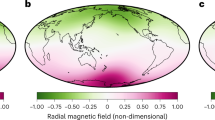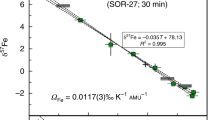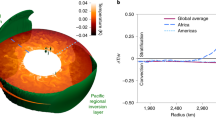Abstract
The Earth’s magnetic field is generated by a dynamo in the liquid iron core, which convects in response to cooling of the overlying rocky mantle. The core freezes from the innermost surface outward, growing the solid inner core and releasing light elements that drive compositional convection1,2,3. Mantle convection extracts heat from the core at a rate that has enormous lateral variations4. Here we use geodynamo simulations to show that these variations are transferred to the inner-core boundary and can be large enough to cause heat to flow into the inner core. If this were to occur in the Earth, it would cause localized melting. Melting releases heavy liquid that could form the variable-composition layer suggested by an anomaly in seismic velocity in the 150 kilometres immediately above the inner-core boundary5,6,7. This provides a very simple explanation of the existence of this layer, which otherwise requires additional assumptions such as locking of the inner core to the mantle, translation from its geopotential centre7,8 or convection with temperature equal to the solidus but with composition varying from the outer to the inner core9. The predominantly narrow downwellings associated with freezing and broad upwellings associated with melting mean that the area of melting could be quite large despite the average dominance of freezing necessary to keep the dynamo going. Localized melting and freezing also provides a strong mechanism for creating seismic anomalies in the inner core itself, much stronger than the effects of variations in heat flow so far considered10.
This is a preview of subscription content, access via your institution
Access options
Subscribe to this journal
Receive 51 print issues and online access
$199.00 per year
only $3.90 per issue
Buy this article
- Purchase on Springer Link
- Instant access to full article PDF
Prices may be subject to local taxes which are calculated during checkout



Similar content being viewed by others
References
Braginsky, S. I. Structure of the F layer and reasons for convection in the Earth’s core. Dokl. Akad. Nauk. SSSR (Engl. Trans.) 149, 1311–1314 (1963)
Labrosse, S., Poirier, J.-P. & Le Mouël, J.-L. On cooling of the Earth’s core. Phys. Earth Planet. Inter. 99, 1–17 (1997)
Nimmo, F., Price, G. D., Brodholt, J. & Gubbins, D. The influence of potassium on core and geodynamo evolution. Geophys. J. Int. 156, 363–376 (2004)
Nakagawa, T. & Tackley, P. J. Lateral variations in CMB heat flux and deep mantle seismic velocity caused by a thermal-chemical-phase boundary layer in 3D spherical convection. Earth Planet. Sci. Lett. 271, 348–358 (2008)
Souriau, A. & Poupinet, G. The velocity profile at the base of the liquid core from PKP(BC+Cdiff) data: an argument in favor of radial inhomogeneity. Geophys. Res. Lett. 18, 2023–2026 (1991)
Song, X. D. & Helmberger, D. V. Velocity structure near the inner core boundary from waveform modeling. J. Geophys. Res. 97, 6573–6586 (1992)
Monnereau, M., Calvet, M., Margerin, L. & Souriau, A. Lopsided growth of Earth’s inner core. Science 328, 1014–1017 (2010)
Alboussière, T., Deguen, R. & Melzani, M. Melting-induced stratification above the Earth’s inner core due to convective translation. Nature 466, 744–747 (2010)
Gubbins, D., Masters, G. & Nimmo, F. A thermochemical boundary layer at the base of Earth’s outer core and independent estimate of core heat flux. Geophys. J. Int. 174, 1007–1018 (2008)
Aubert, J., Amit, H. & Hulot, G. Detecting thermal boundary control in surface flows from numerical dynamos. Phys. Earth Planet. Inter. 160, 143–156 (2007)
Masters, T. G., Johnson, S., Laske, G. & Bolton, H. F. A shear-velocity model of the mantle. Phil. Trans. R. Soc. Lond. A 354, 1385–1411 (1996)
Zhang, K. & Gubbins, D. Convection in a rotating spherical fluid shell with an inhomogeneous temperature boundary condition at finite Prandtl number. Phys. Fluids 8, 1141–1148 (1996)
Zhang, K. & Gubbins, D. Scale disparities and magnetohydrodynamics in the Earth’s core. Phil. Trans. R. Soc. Lond. A 358, 899–920 (2000)
Gibbons, S. & Gubbins, D. Convection in the Earth's core driven by lateral variations in the core-mantle boundary heat flux. Geophys. J. Int. 142, 631–642 (2000)
Sreenivasan, B. On dynamo action produced by boundary thermal coupling. Phys. Earth Planet. Inter. 177, 130–138 (2009)
Bloxham, J. The effect of thermal core-mantle interactions on the paleomagnetic secular variation. Phil. Trans. R. Soc. Lond. A 358, 1171–1179 (2000)
Christensen, U., Olson, P. & Glatzmaier, G. A. A dynamo model interpretation of geomagnetic field structures. Geophys. Res. Lett. 25, 1565–1568 (1998)
Olson, P. & Christensen, U. R. The time-averaged magnetic field in numerical dynamos with non-uniform boundary heat flow. Geophys. J. Int. 151, 809–823 (2002)
Christensen, U. R. & Olson, P. Secular variation in numerical geodynamo models with lateral variations of boundary heat flow. Phys. Earth Planet. Inter. 138, 39–54 (2003)
Glatzmaier, G. A., Coe, R. S., Hongre, L. & Roberts, P. H. The role of the Earth’s mantle in controlling the frequency of geomagnetic reversals. Nature 401, 885–890 (1999)
Kutzner, C. & Christensen, U. R. Simulated geomagnetic reversals and preferred virtual geomagnetic pole paths. Geophys. J. Int. 157, 1105–1118 (2004)
Gubbins, D., Willis, A. P. & Sreenivasan, B. Correlation of Earth’s magnetic field with lower mantle thermal and seismic structure. Phys. Earth Planet. Inter. 162, 256–260 (2007)
Sreenivasan, B. & Gubbins, D. Dynamos with weakly convecting outer layers: implications for core–mantle boundary interaction. Geophys. Astrophys. Fluid Dyn. 102, 395–407 (2008)
Buffett, B. A. & Seagle, C. T. Stratification of the top of the core due to chemical interactions with the mantle. J. Geophys. Res. 115, B04407 (2010)
Helffrich, G. & Kaneshima, S. Outer-core compositional stratification from observed core wave speed profiles. Nature 468, 807–810 (2010)
Dziewonski, A. M. & Anderson, D. L. Preliminary Reference Earth Model. Phys. Earth Planet. Inter. 25, 297–356 (1981)
Gubbins, D., Alfè, D., Masters, T. G. & Price, D. Gross thermodynamics of 2-component core convection. Geophys. J. Int. 157, 1407–1414 (2004)
Moffatt, H. K. & Loper, D. E. The magnetostrophic rise of a buoyant parcel in the Earth’s core. Geophys. J. Int. 117, 394–402 (1994)
Aubert, J., Amit, H., Hulot, G. & Olson, P. Thermochemical flows couple the Earth’s inner core growth to mantle heterogeneity. Nature 454, 758–761 (2008)
Sreenivasan, B. A buoyant flow structure in a magnetic field: quasi-steady states and linear–nonlinear transitions. Phys. Lett. A 372, 5471–5478 (2008)
Sreenivasan, B. & Jones, C. A. The role of inertia in the evolution of spherical dynamos. Geophys. J. Int. 164, 467–476 (2006)
Author information
Authors and Affiliations
Contributions
B.S. set up the geodynamo model and performed the calculations that form the basis of this paper. All four authors discussed the results and contributed to the text of the manuscript.
Corresponding author
Ethics declarations
Competing interests
The authors declare no competing financial interests.
Rights and permissions
About this article
Cite this article
Gubbins, D., Sreenivasan, B., Mound, J. et al. Melting of the Earth’s inner core. Nature 473, 361–363 (2011). https://doi.org/10.1038/nature10068
Received:
Accepted:
Published:
Issue Date:
DOI: https://doi.org/10.1038/nature10068
This article is cited by
-
An initial map of fine-scale heterogeneity in the Earth’s inner core
Nature Geoscience (2022)
-
A coupled core-mantle evolution: review and future prospects
Progress in Earth and Planetary Science (2020)
-
Regional stratification at the top of Earth's core due to core–mantle boundary heat flux variations
Nature Geoscience (2019)
-
Non quasi-Hemispherical Seismological Pattern of the Earth’s Uppermost Inner Core
Scientific Reports (2018)
-
Complex inner core boundary from frequency characteristics of the reflection coefficients of PKiKP waves observed by Hi-net
Progress in Earth and Planetary Science (2015)
Comments
By submitting a comment you agree to abide by our Terms and Community Guidelines. If you find something abusive or that does not comply with our terms or guidelines please flag it as inappropriate.



